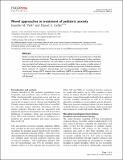Novel approaches in treatment of pediatric anxiety
Citation
Park, Jennifer M., and Daniel A. Geller. 2014. “Novel approaches in treatment of pediatric anxiety.” F1000Prime Reports 6 (1): 30. doi:10.12703/P6-30. http://dx.doi.org/10.12703/P6-30.Abstract
Pediatric anxiety disorders have high prevalence rates and morbidity and are associated with considerable functional impairment and distress. They may be predictors for the development of other psychiatric disorders and, without intervention, are more likely to persist into adulthood. While evidence-based pharmacological and behavioral interventions are currently available, there remains a sizable subset of youth who remain only partially treatment-responsive and therefore symptomatic following treatment. Novel methods of treatment, pharmacologic and non-pharmacologic, including acceptance and commitment therapy (ACT), attention bias modification (ABM), d-cycloserine (DCS) augmentation of cognitive behavioral treatment (CBT), and glutamatergic agents such as riluzole, are briefly introduced and discussed.Other Sources
http://www.ncbi.nlm.nih.gov/pmc/articles/PMC4017908/pdf/Terms of Use
This article is made available under the terms and conditions applicable to Other Posted Material, as set forth at http://nrs.harvard.edu/urn-3:HUL.InstRepos:dash.current.terms-of-use#LAACitable link to this page
http://nrs.harvard.edu/urn-3:HUL.InstRepos:12406936
Collections
- HMS Scholarly Articles [17920]
Contact administrator regarding this item (to report mistakes or request changes)



